Abstract
The reactions of a monoclonal antibody to the MCF7 breast cancer cell line were immunohistochemically studied on a variety of breast tumors, primary and metastatic, on mammary epithelium and on nonneoplastic breast lesions. A high proportion of positive reactions was observed in ductal, lobular, and tubular carcinomas as well as in mammary Paget's disease. Mucinous, medullary, and papillary carcinomas showed a low incidence of reactivity. Carcinomas with metaplasia, carcinoids, and nonepithelial breast tumors were unreactive with the antibody. Positive immunostaining was documented also in nodal and extranodal metastatic lesions. The staining of nodal metastases was correlated with the positive reaction of the primary tumor. Reactivity was widely distributed in normal breast epithelial cells and in benign breast lesions. Staining of nonneoplastic mammary epithelial was associated with reactivity of adjacent neoplastic tissues. Staining differences between nonneoplastic and neoplastic mammary tissues were related to the intensity and cytologic distribution of the labeling. Heterogeneous reactivity of morphologically similar cells was documented in nonneoplastic and neoplastic breast epithelial cells as well as in nodal and extranodal breast carcinoma metastases. Immunohistologically detectable antigen was not correlated with prognostic factors such as histologic grade or nodal status. A retrospective study of T1NO cases failed to substantiate any prognostic value for the reactivity of primary breast tumors with this monoclonal antibody.
Full text
PDF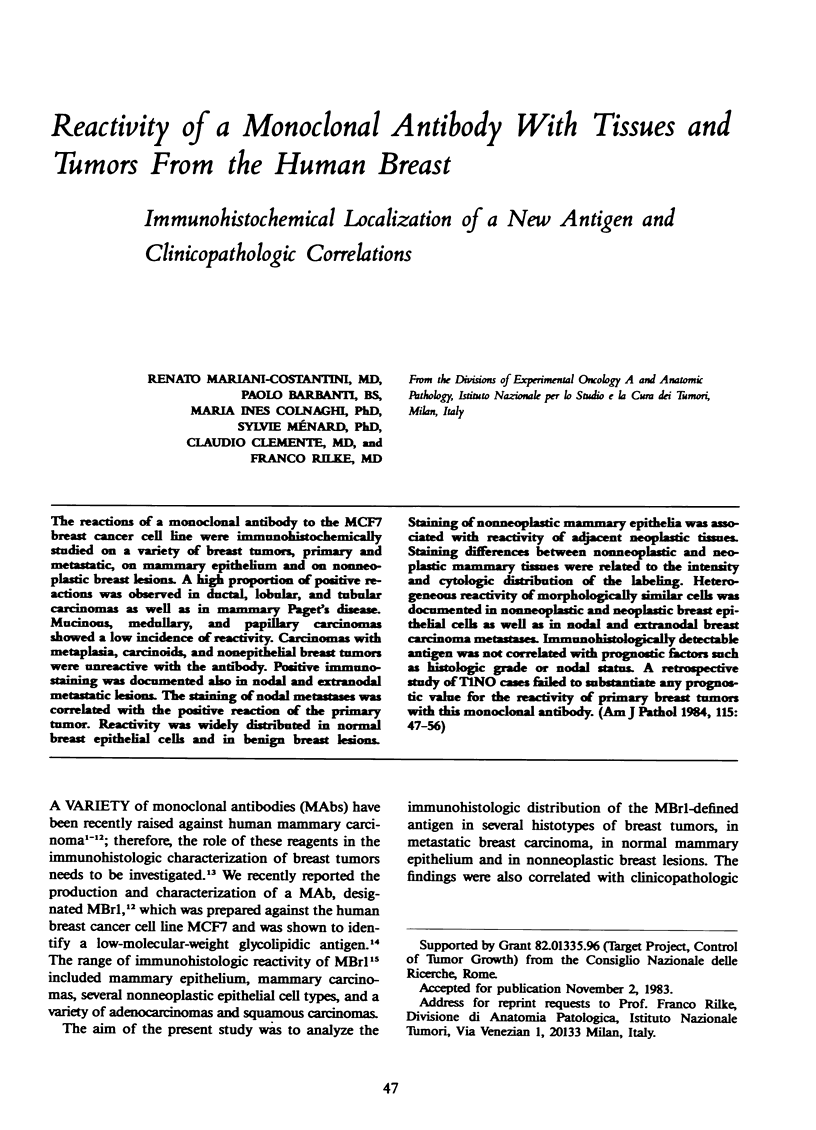
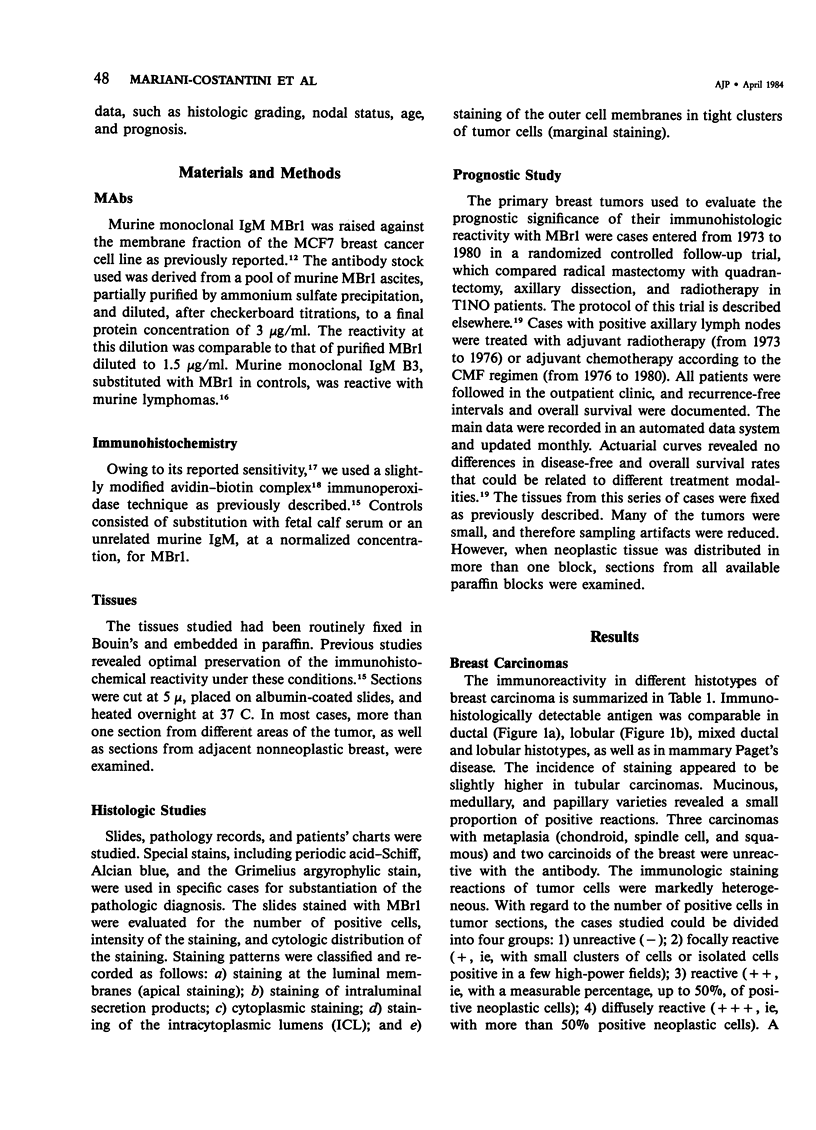
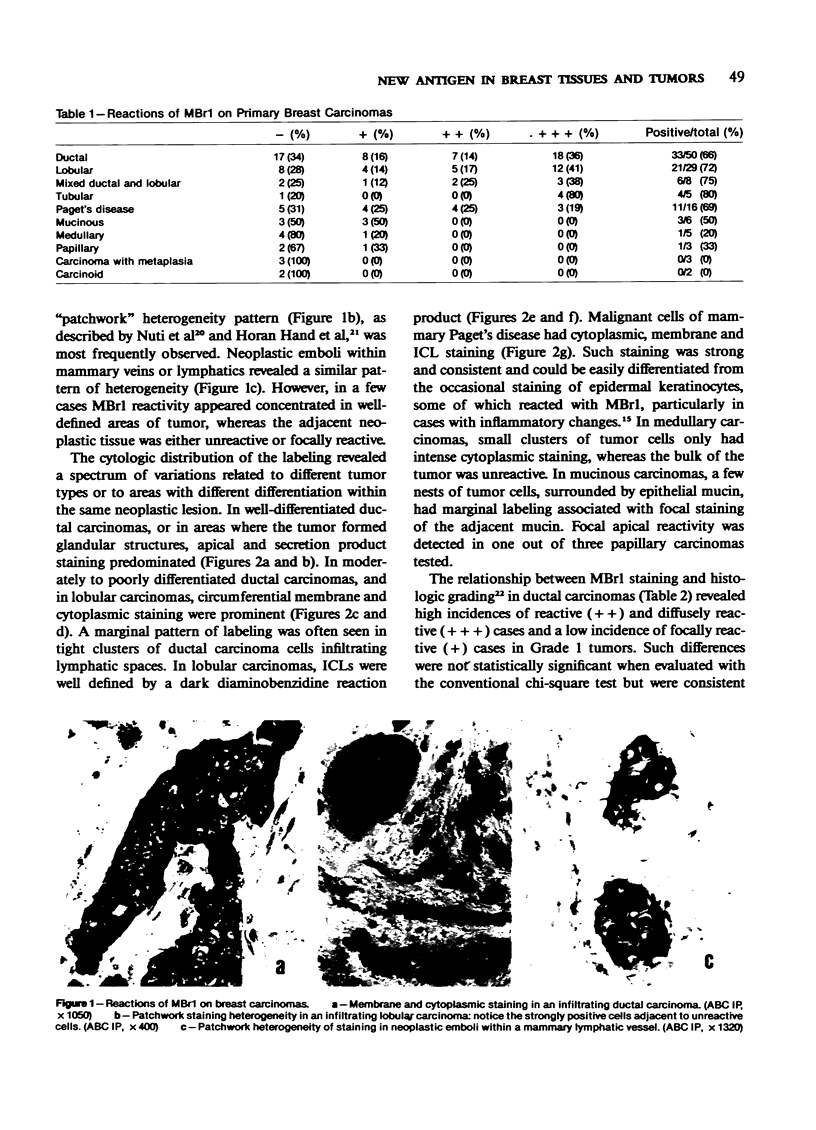
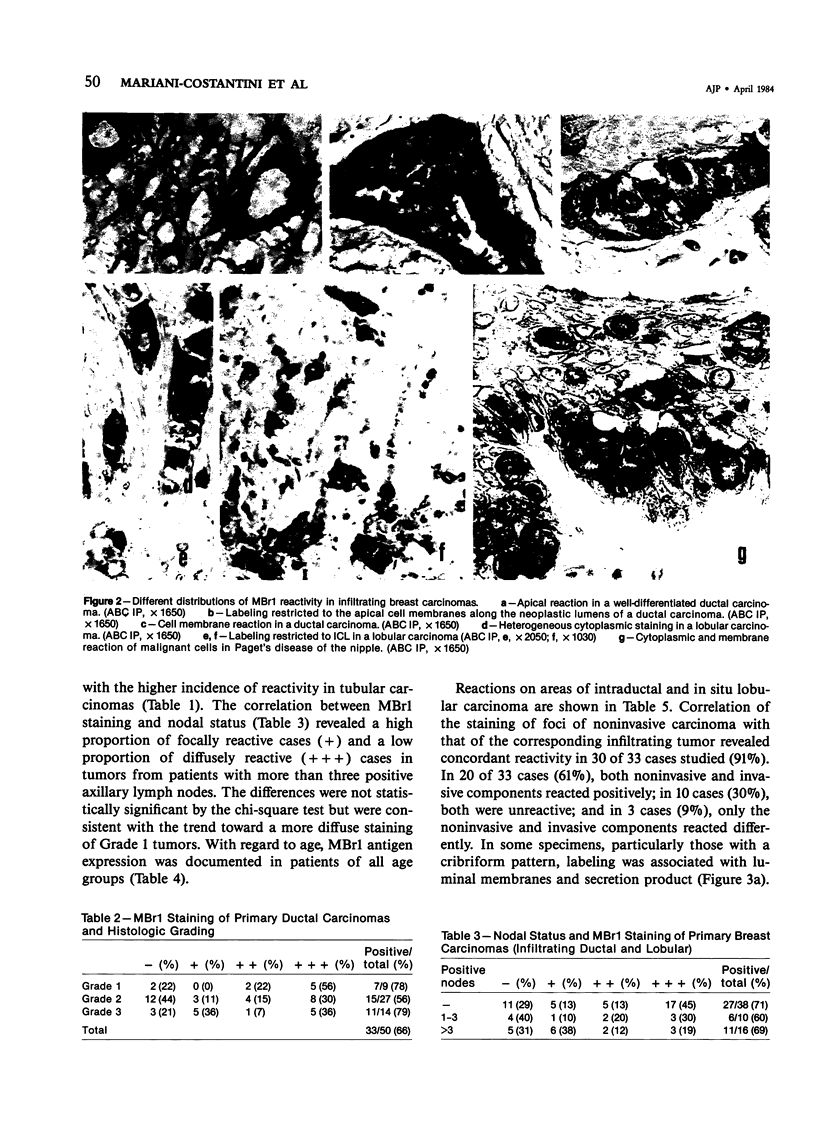
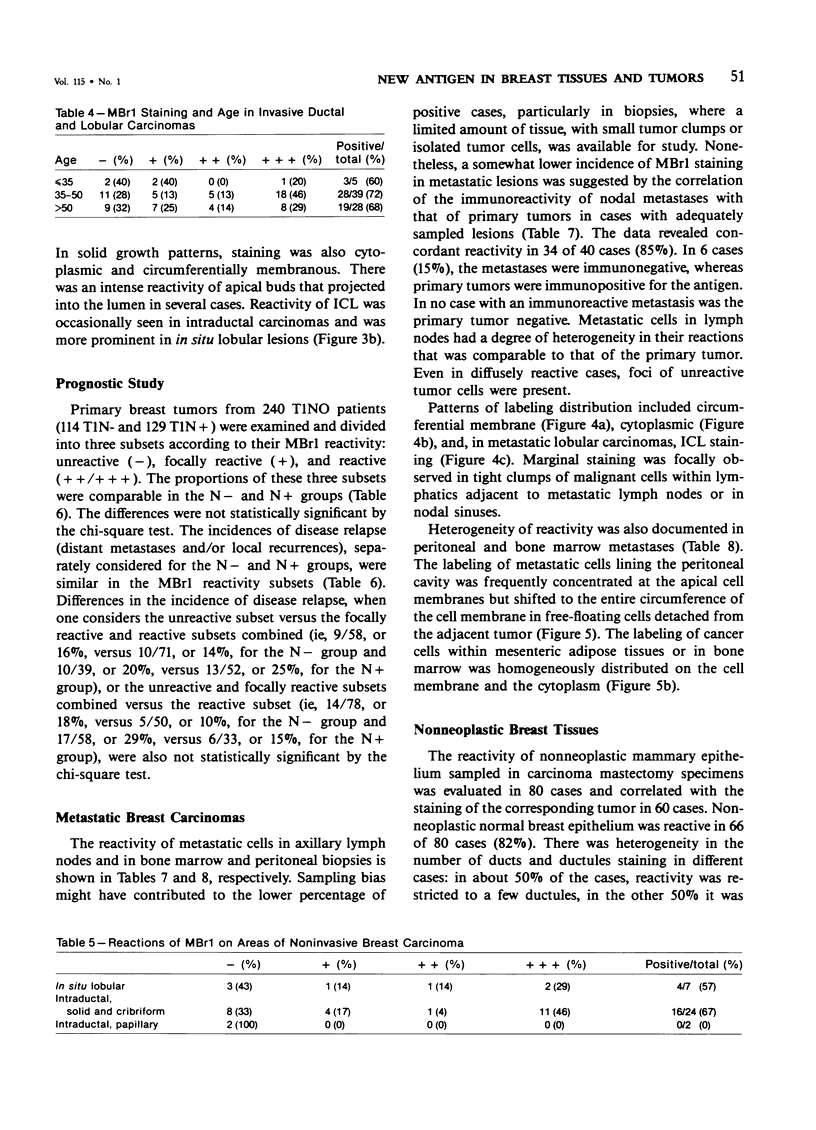
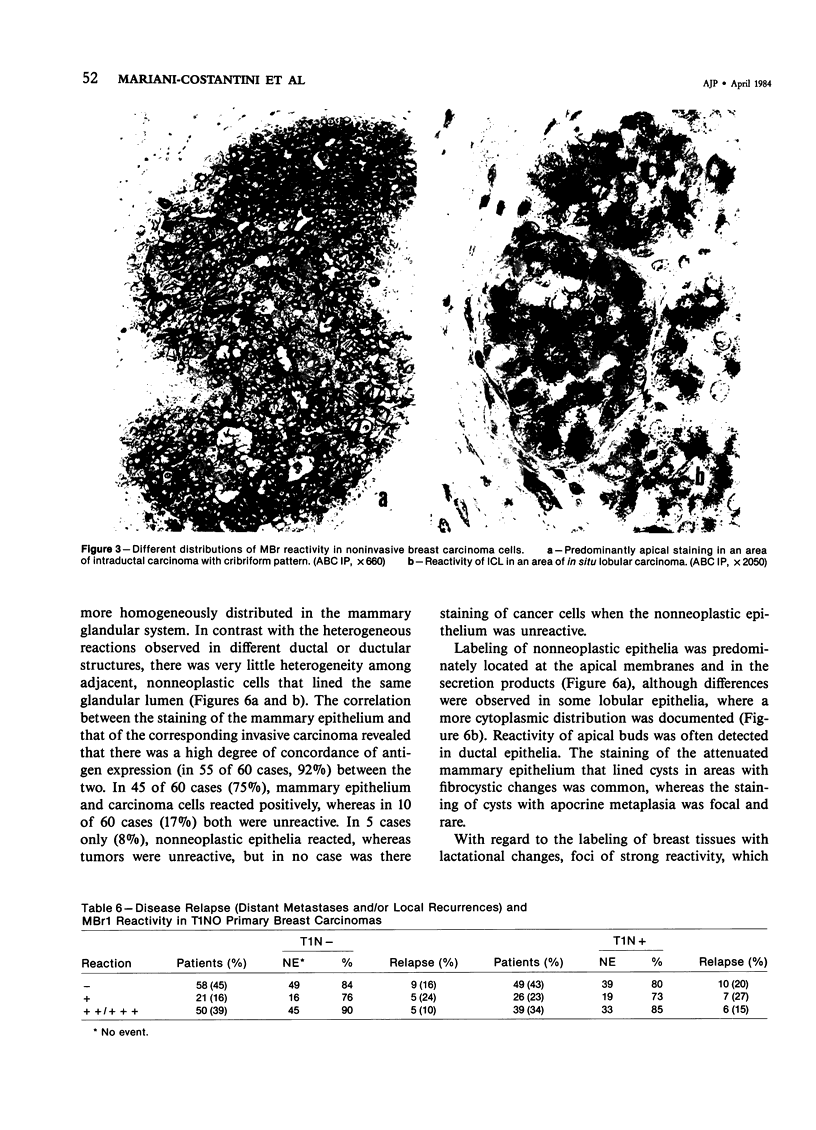
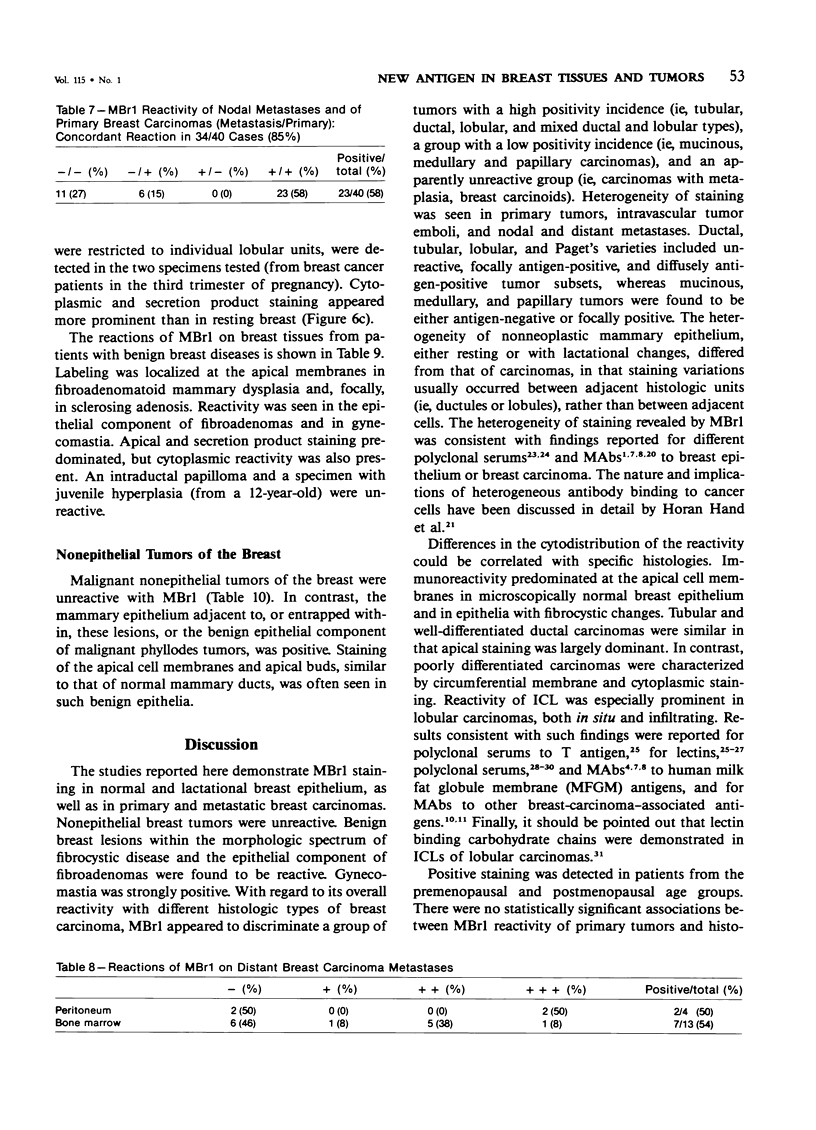
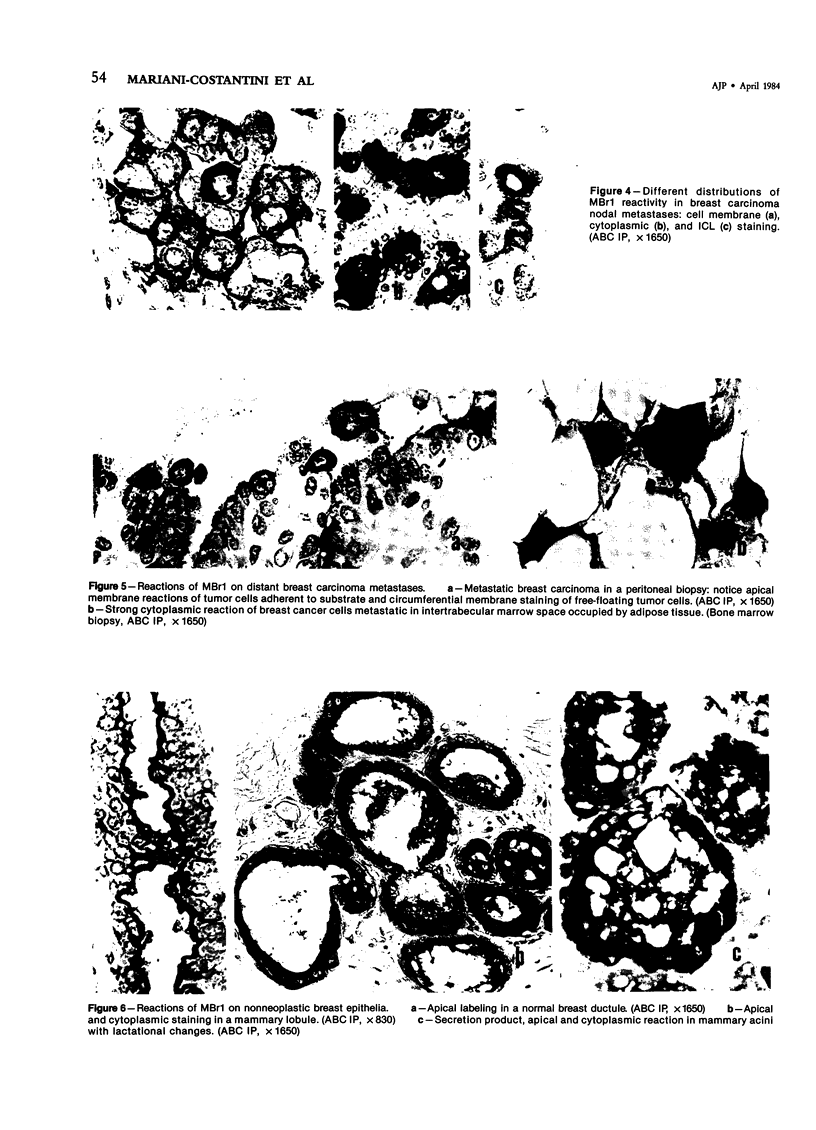
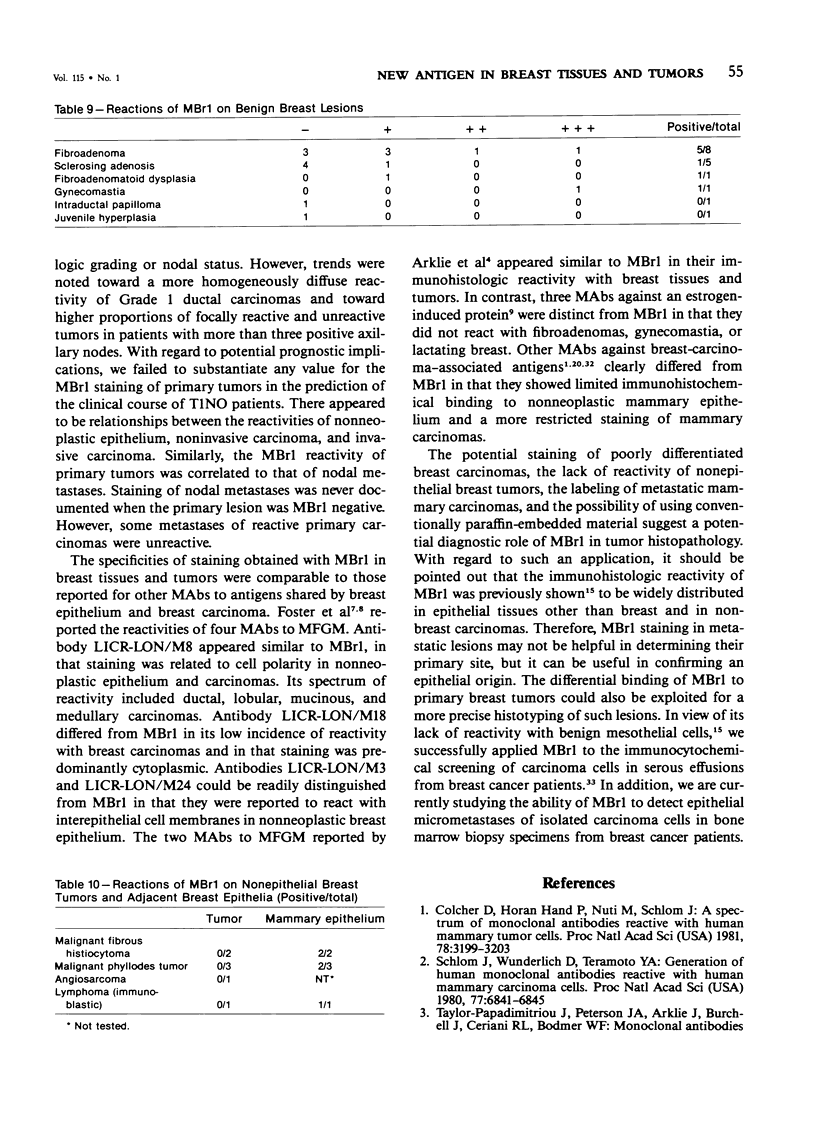
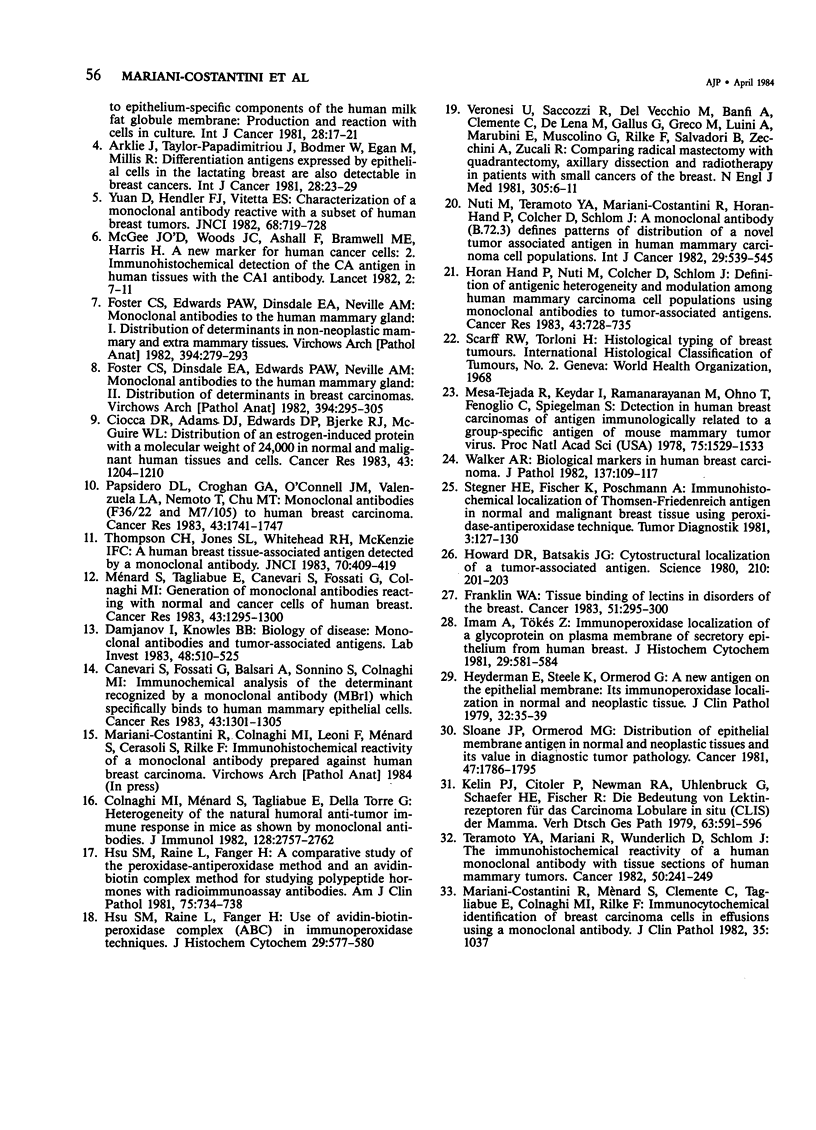
Images in this article
Selected References
These references are in PubMed. This may not be the complete list of references from this article.
- Arklie J., Taylor-Papadimitrious J., Bodmer W., Egan M., Millis R. Differentiation antigens expressed by epithelial cells in the lactating breast are also detectable in breast cancers. Int J Cancer. 1981 Jul 15;28(1):23–29. doi: 10.1002/ijc.2910280105. [DOI] [PubMed] [Google Scholar]
- Cal A. E. Disease and the conquest of America. Belcast J Belizean Aff. 1985;2(1):7–11. [PubMed] [Google Scholar]
- Canevari S., Fossati G., Balsari A., Sonnino S., Colnaghi M. I. Immunochemical analysis of the determinant recognized by a monoclonal antibody (MBr1) which specifically binds to human mammary epithelial cells. Cancer Res. 1983 Mar;43(3):1301–1305. [PubMed] [Google Scholar]
- Ciocca D. R., Adams D. J., Edwards D. P., Bjercke R. J., McGuire W. L. Distribution of an estrogen-induced protein with a molecular weight of 24,000 in normal and malignant human tissues and cells. Cancer Res. 1983 Mar;43(3):1204–1210. [PubMed] [Google Scholar]
- Colcher D., Hand P. H., Nuti M., Schlom J. A spectrum of monoclonal antibodies reactive with human mammary tumor cells. Proc Natl Acad Sci U S A. 1981 May;78(5):3199–3203. doi: 10.1073/pnas.78.5.3199. [DOI] [PMC free article] [PubMed] [Google Scholar]
- Colnaghi M. I., Menard S., Tagliabue E., Torre G. D. Heterogeneity of the natural humoral anti-tumor immune response in mice as shown by monoclonal antibodies. J Immunol. 1982 Jun;128(6):2757–2762. [PubMed] [Google Scholar]
- Damjanov I., Knowles B. B. Biology of disease. Monoclonal antibodies and tumor-associated antigens. Lab Invest. 1983 May;48(5):510–525. [PubMed] [Google Scholar]
- Foster C. S., Dinsdale E. A., Edwards P. A., Neville A. M. Monoclonal antibodies to the human mammary gland. II. Distribution of determinants in breast carcinomas. Virchows Arch A Pathol Anat Histol. 1982;394(3):295–305. doi: 10.1007/BF00430672. [DOI] [PubMed] [Google Scholar]
- Foster C. S., Edwards P. A., Dinsdale E. A., Neville A. M. Monoclonal antibodies to the human mammary gland. I. Distribution of determinants in non-neoplastic mammary and extra mammary tissues. Virchows Arch A Pathol Anat Histol. 1982;394(3):279–293. doi: 10.1007/BF00430671. [DOI] [PubMed] [Google Scholar]
- Franklin W. A. Tissue binding of lectins in disorders of the breast. Cancer. 1983 Jan 15;51(2):295–300. doi: 10.1002/1097-0142(19830115)51:2<295::aid-cncr2820510222>3.0.co;2-t. [DOI] [PubMed] [Google Scholar]
- Hand P. H., Nuti M., Colcher D., Schlom J. Definition of antigenic heterogeneity and modulation among human mammary carcinoma cell populations using monoclonal antibodies to tumor-associated antigens. Cancer Res. 1983 Feb;43(2):728–735. [PubMed] [Google Scholar]
- Heyderman E., Steele K., Ormerod M. G. A new antigen on the epithelial membrane: its immunoperoxidase localisation in normal and neoplastic tissue. J Clin Pathol. 1979 Jan;32(1):35–39. doi: 10.1136/jcp.32.1.35. [DOI] [PMC free article] [PubMed] [Google Scholar]
- Howard D. R., Batsakis J. G. Cytostructural localization of a tumor-associated antigen. Science. 1980 Oct 10;210(4466):201–203. doi: 10.1126/science.6997995. [DOI] [PubMed] [Google Scholar]
- Hsu S. M., Raine L., Fanger H. A comparative study of the peroxidase-antiperoxidase method and an avidin-biotin complex method for studying polypeptide hormones with radioimmunoassay antibodies. Am J Clin Pathol. 1981 May;75(5):734–738. doi: 10.1093/ajcp/75.5.734. [DOI] [PubMed] [Google Scholar]
- Imam A., Tökés Z. A. Immunoperoxidase localization of a glycoprotein on plasma membrane of secretory epithelium from human breast. J Histochem Cytochem. 1981 Apr;29(4):581–584. doi: 10.1177/29.4.7019309. [DOI] [PubMed] [Google Scholar]
- Mariani-Costantini R., Ménard S., Clemente C., Tagliabue E., Colnaghi M. I., Rilke F. Immunocytochemical identification of breast carcinoma cells in effusions using a monoclonal antibody. J Clin Pathol. 1982 Sep;35(9):1037–1037. doi: 10.1136/jcp.35.9.1037. [DOI] [PMC free article] [PubMed] [Google Scholar]
- Mesa-Tejada R., Keydar I., Ramanarayanan M., Ohno T., Fenoglio C., Spiegelman S. Detection in human breast carcinomas of an antigen immunologically related to a group-specific antigen of mouse mammary tumor virus. Proc Natl Acad Sci U S A. 1978 Mar;75(3):1529–1533. doi: 10.1073/pnas.75.3.1529. [DOI] [PMC free article] [PubMed] [Google Scholar]
- Mènard S., Tagliabue E., Canevari S., Fossati G., Colnaghi M. I. Generation of monoclonal antibodies reacting with normal and cancer cells of human breast. Cancer Res. 1983 Mar;43(3):1295–1300. [PubMed] [Google Scholar]
- Nuti M., Teramoto Y. A., Mariani-Costantini R., Hand P. H., Colcher D., Schlom J. A monoclonal antibody (B72.3) defines patterns of distribution of a novel tumor-associated antigen in human mammary carcinoma cell populations. Int J Cancer. 1982 May 15;29(5):539–545. doi: 10.1002/ijc.2910290509. [DOI] [PubMed] [Google Scholar]
- Papsidero L. D., Croghan G. A., O'Connell M. J., Valenzuela L. A., Nemoto T., Chu T. M. Monoclonal antibodies (F36/22 and M7/105) to human breast carcinoma. Cancer Res. 1983 Apr;43(4):1741–1747. [PubMed] [Google Scholar]
- Schlom J., Wunderlich D., Teramoto Y. A. Generation of human monoclonal antibodies reactive with human mammary carcinoma cells. Proc Natl Acad Sci U S A. 1980 Nov;77(11):6841–6845. doi: 10.1073/pnas.77.11.6841. [DOI] [PMC free article] [PubMed] [Google Scholar]
- Sloane J. P., Ormerod M. G. Distribution of epithelial membrane antigen in normal and neoplastic tissues and it value in diagnostic tumor pathology. Cancer. 1981 Apr 1;47(7):1786–1795. doi: 10.1002/1097-0142(19810401)47:7<1786::aid-cncr2820470711>3.0.co;2-8. [DOI] [PubMed] [Google Scholar]
- Taylor-Papadimitriou J., Peterson J. A., Arklie J., Burchell J., Ceriani R. L., Bodmer W. F. Monoclonal antibodies to epithelium-specific components of the human milk fat globule membrane: production and reaction with cells in culture. Int J Cancer. 1981 Jul 15;28(1):17–21. doi: 10.1002/ijc.2910280104. [DOI] [PubMed] [Google Scholar]
- Teramoto Y. A., Meriani R., Wunderlich D., Schlom J. The immunohistochemical reactivity of a human monoclonal antibody with tissue sections of human mammary tumors. Cancer. 1982 Jul 15;50(2):241–249. doi: 10.1002/1097-0142(19820715)50:2<241::aid-cncr2820500214>3.0.co;2-5. [DOI] [PubMed] [Google Scholar]
- Thompson C. H., Jones S. L., Whitehead R. H., McKenzie I. F. A human breast tissue-associated antigen detected by a monoclonal antibody. J Natl Cancer Inst. 1983 Mar;70(3):409–419. [PubMed] [Google Scholar]
- Veronesi U., Saccozzi R., Del Vecchio M., Banfi A., Clemente C., De Lena M., Gallus G., Greco M., Luini A., Marubini E. Comparing radical mastectomy with quadrantectomy, axillary dissection, and radiotherapy in patients with small cancers of the breast. N Engl J Med. 1981 Jul 2;305(1):6–11. doi: 10.1056/NEJM198107023050102. [DOI] [PubMed] [Google Scholar]
- Walker R. A. Biological markers in human breast carcinoma. J Pathol. 1982 Jun;137(2):109–117. doi: 10.1002/path.1711370204. [DOI] [PubMed] [Google Scholar]
- Yuan D., Hendler F. J., Vitetta E. S. Characterization of a monoclonal antibody reactive with a subset of human breast tumors. J Natl Cancer Inst. 1982 May;68(5):719–728. [PubMed] [Google Scholar]








